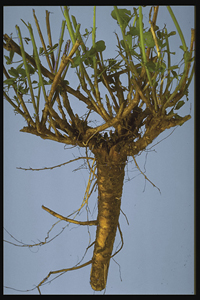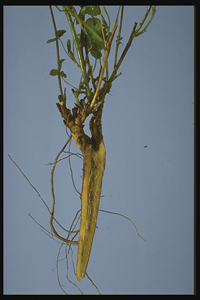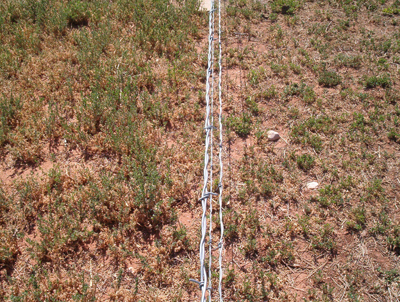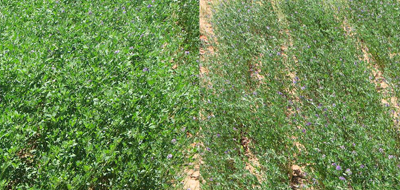Circular 646
Leonard Lauriault, Mark Marsalis, Francisco E. Contreras-Govea, and Sangu Angadi
College of Agricultural, Consumer and Environmental Sciences, New Mexico State University
Authors: Respectively, Forage Agronomist, Agricultural Science Center at Tucumcari; Extension Agronomy Specialist, Agricultural Science Center at Clovis; Agronomist, Agricultural Science Center at Artesia; and Crop Stress Physiologist, Agricultural Science Center at Clovis, all of New Mexico State University. (Print Friendly PDF)
Water is the most important limiting factor for alfalfa production in New Mexico, and lack of rainfall over extended periods reduces water available for irrigation. When prolonged dry conditions occur in New Mexico and water for irrigation is in short supply, alfalfa growers should consider strategies to protect their alfalfa stands for future years. Since the shortage of water may be alleviated at any time by significant precipitation replenishing the state's rivers and lakes, the goal is to preserve the health of the stand during drought so as to optimize growth once irrigation can be resumed.
Because alfalfa can go dormant during extended dry periods, it is one of the few legumes that can withstand long-term drought (Figure 1; Sheaffer et al., 1988b) and still recover once adequate precipitation or irrigation occurs (Ottman et al., 1996). Alfalfa plants can survive as long as their crown and roots remain viable—indicated by a lack of splitting or other external damage and a uniform white color with minimal internal discoloration (Figure 2; Undersander et al., 1998). If enough plants survive for the stand to remain productive (5 plants per square foot or 40 stems per square foot [Undersander et al., 1998]), the field should become fully productive again when it recovers from the drought. Unlike shallow-rooted plants, alfalfa can secure moisture from lower depths in the soil (Sheaffer et al., 1988b). Thus, even when producers have less than optimum irrigation capabilities or no water for irrigation, alfalfa often can produce harvestable forage—whether harvested as stored feed or by grazing—whenever significant precipitation occurs (Figure 3).
Some key strategies to consider during drought conditions in alfalfa include harvest management, irrigation management (if water is available), insect control, and fertilization.

Figure 1. Alfalfa (far left) was the only one of seven perennial legumes to survive for five years without irrigation in a study at New Mexico State University's Agricultural Science Center at Tucumcari. The average annual precipitation at Tucumcari is approximately 16 inches.


Figure 2. Healthy alfalfa crowns (left) have multiple branches and little or no evidence of splitting. Healthy alfalfa roots (right) will be uniformly off-white or have less than one-third of their diameter discolored. (Images by Dan Undersander, Wisconsin Cooperative Extension Service, used with permission.)

Figure 3. Rainfed alfalfa in June 2003 near Tucumcari, NM. A major portion of the ungrazed alfalfa on the left was approximately 12 inches tall.
Harvest Management
Harvest management during drought is similar in purpose to fall harvest management. The goal in fall harvest management is to allow a sufficient autumn rest period for plants to restock root energy for winter survival and spring green up (Sheaffer et al., 1988a). The goal in drought harvest management is maintenance of leaf area for photosynthesis—this provides continuous energy to sustain plant functions without depleting root reserves, so that the alfalfa can survive.
If harvesting top growth above 6 inches is economically feasible, cuttings or grazing should be scheduled to minimize plant stress. During periods of drought, if growth is sufficient, the alfalfa should be allowed to reach at least 10% bloom before harvesting, enabling plants to better handle the dry weather and cutting stresses (Sheaffer et al., 1988a).
At the same time, a stubble height of at least 6 inches should be left to maintain energy for regrowth. Continuous light grazing that maintains sufficient leaf area also is feasible, but the pasture should be monitored closely (Lauriault et al., 2005).
Drought-stressed alfalfa will initiate flowering earlier than non-stressed alfalfa. Plants will, therefore, be shorter with less leaf growth to help replenish root energy needed for regrowth (Hall, 1996). Although leaf growth is restricted compared to a non-drought year, stem growth is even more restricted, leading to a higher leaf-to-stem ratio and, therefore, higher quality of the more mature alfalfa forage. Consequently, delaying harvest to greater than 10% bloom does not lead to a quality reduction in drought-stressed alfalfa as it does for alfalfa that is watered well (Hall, 1996).
Regrowth from crown buds will begin after alfalfa has initiated flowering, likely resulting in two different growth stages. This complicates harvest decisions because the regrowth from the crown uses energy stored in the roots that the plant will not have had time to replenish. Harvesting all leaf material will cause the plant to use even more of its energy reserves for regrowth. Maintaining a minimum 6-inch stubble will minimize the drain of root energy, saving it for future needs such as winter survival. Delaying cutting may decrease forage quality and the number of cuttings; however, it will promote stand persistence by supporting plant survival during the drought, and it will save on harvest costs. If areas of the field vary in maturity, base harvest timing on the least mature plants in the field.
Irrigation Management
Alfalfa uses water more efficiently during the spring when temperatures are more moderate (Anderson, 2008). Consequently, if water is available but limited in supply for season long irrigation, yields will be maximized by concentrating the water on the early cuttings and then terminating irrigation to allow the alfalfa to enter drought-induced dormancy (Henson, 2008). Irrigation termination for more than one cutting will reduce total annual yield, and recovery will be delayed until the second or later regrowth after drought-induced dormancy is broken (Ottman et al., 1996). Consequently, if water becomes available later in the season, producers should consider irrigating as soon as possible as many acres as can be fully irrigated for the remainder of the season—if water will be available for that long—after harvesting the standing crop on that acreage. If the water will only be available for the current cutting, irrigate as many acres as possible at the typical full irrigation rate for that location. Any remaining acreage that cannot be adequately irrigated should be allowed to remain dormant and managed to minimize drought stress.
Irrigations at any time, even when water is plentiful, should be applied between cuttings after the canopy has closed to minimize germination of weeds that can outcompete the already weakened alfalfa plants (Anderson, 2008). Additionally, if salinity of available irrigation water increases due to drought, the water requirement of alfalfa may also increase. Alfalfa yields can be reduced when poor quality irrigation water is used, and the weakened plants become even more susceptible to drought stress. Consequently, irrigation water should be tested occasionally to monitor for changes in quality.
Insect Control
Another issue during drought is insect control. During dry periods, rangeland insects such as grasshoppers may migrate into alfalfa fields, adding additional stress to the crop. With hot and dry conditions, insect populations also increase rapidly; hence, more frequent scouting is necessary, especially when regrowth is initiated after harvest or by flowering. Aphid populations should be of specific concern. Producers should pay particular attention to new growth, even if a standing hay crop remains in the field, because the new growth will be more readily consumed or infested by insects. Producers should also note that blister beetles, which are toxic to livestock, are attracted by grasshoppers and by alfalfa flowers (Caddel et al., 2001). Hence, if alfalfa is allowed to bloom before harvest (as it should be during drought), fields should be monitored for these insects just prior to harvest.
Fertilization
Plants under drought stress allocate resources to survival over biomass production, resulting in lower forage production (Figure 4); however, nutrient availability remains critical during drought. Soil testing every 3 years is sufficient to determine particular nutrient needs of alfalfa. Fertilizer should be applied prior to the initiation of growth in spring to minimize traffic on actively growing alfalfa so that stems are not damaged.

Figure 4. The effect of irrigation management on alfalfa growth at Tucumcari in 2007 as indicated by well-irrigated alfalfa on the left and unirrigated alfalfa on the right.
Always apply fertilizer based on soil test recommendations for alfalfa at a lower level of production. Although boron deficiencies are rare in New Mexico, producers should pay close attention to that nutrient because deficiencies can be enhanced during dry weather. Typical symptoms of boron deficiency include a yellowing of the newer, upper leaves. Always verify plant deficiencies for boron and other micronutrients with plant tissue analysis in combination with concurrent soil analysis. Over-fertilization should always be avoided. If for some reason nitrate-N is elevated in the field, the alfalfa forage should be evaluated for nitrate content to avoid toxicity to livestock (Allison, 1998).
These key management practices should be followed to help alfalfa to persist during drought years. For further information about alfalfa management, contact your County Cooperative Extension office or visit the NMSU Cooperative Extension Service publications Web site agronomy page (https://pubs.nmsu.edu/_a).
References
Allison, C.D. 1998. Nitrate poisoning of livestock. Guide B-807. New Mexico State Univ. Coop. Ext. Ser. Las Cruces, NM.
Anderson, B. 2008. Irrigating alfalfa—More than flipping a switch. Proc. Nat'l Alfalfa Symp. (CD-ROM) Kearney, NE.
Caddel, J., J. Stritzke, R. Berberet, P. Bolin, R. Huhnke, G. Johnson, M. Kizer, D. Lalman, P. Mulder, D. Waldner, C. Ward, and J. Zhang. 2001. Alfalfa production guide for the southern Great Plains. E-826.
Hall, M. 1996. How an alfalfa plant develops. PE-17347. Certified Alfalfa Seed Council. St. Paul, MN.
Henson, B. 2008. Alfalfa (In Univ. CA drought management). Online: https://ucmanagedrought.ucdavis.edu/alfalfa.cfm (Accessed: 18 June 2009; 5 pp). Univ. California Agric. and Nat. Res. Davis, CA.
Lauriault, L.M., R.E. Kirksey, G.B. Donart, J.E. Sawyer, and D.M. VanLeeuwen. 2005. Pasture and stocker cattle performance on furrow-irrigated alfalfa-tall wheatgrass pastures, Southern High Plains. Crop Sci. 45:305-315.
Ottman, M.J., B.R. Tickes, and R.L. Roth. 1996. Alfalfa yield and stand response to irrigation termination in an arid environment. Agron. J. 88:44-48.
Sheaffer, C.C., G.D. Lacefield, and V.L. Marble. 1988a. Cutting schedules and stands. Pp. 411-437. In A.A. Hanson, D.K. Barnes, and R.R. Hill (ed.) Alfalfa and alfalfa improvement. Agron. Monograph 29. ASA-CSSA-SSSA, Madison, WI.
Sheaffer, C.C., C.B. Tanner, and M.B. Kirkham. 1988b. Alfalfa water relations and irrigation. Pp. 373-409. In A.A. Hanson, D.K. Barnes, and R.R. Hill (ed.) Alfalfa and alfalfa improvement. Agron. Monograph 29. ASA-CSSA-SSSA, Madison, WI.
Undersander, D., C. Grau, D. Cosgrove, J. Doll, and N. Martin. 1998. Alfalfa stand assessment: Is this stand good enough to keep? A3620. (Accessed: 19 June 2009; 4 pp). Univ. Wisconsin Coop. Ext. Ser. Madison, WI.
To find more resources for your business, home, or family, visit the College of Agricultural, Consumer and Environmental Sciences on the World Wide Web at pubs.nmsu.edu
Contents of publications may be freely reproduced for educational purposes. All other rights reserved. For permission to use publications for other purposes, contact pubs@nmsu.edu or the authors listed on the publication.
New Mexico State University is an equal opportunity/affirmative action employer and educator. NMSU and the U.S. Department of Agriculture cooperating.
Published and electronically distributed October 2009, Las Cruces, NM.


